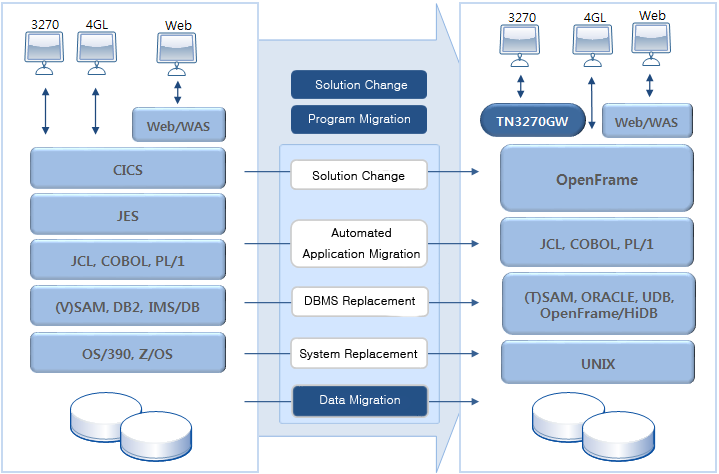Rehosting Solution
This chapter introduces and describes the concept of rehosting.
1. Introduction
When migrating a business application system from a mainframe environment to an open system environment, you are often required to modify the application logic and code because of the differences in hardware and operating systems between them. Completely rebuilding a business application for use in a new production environment can be very expensive, time-consuming, and complex.
A rehosting solution can be used to migrate the mainframe applications and data to an open system. It provides functions to transform the source application logic to be compatible with an open system. Rehosting is more cost efficient than rebuilding the system because it requires minimal changes to the application logic.
OpenFrame, a rehosting solution from TmaxSoft, is an effective, efficient product that migrates a business application system from a legacy mainframe system to a more flexible, open environment.
This chapter introduces rehosting and some commonly used rehosting methods and explains why the rehosting strategy is gaining more attention. It also describes the migration process, and how to use OpenFrame for rehosting.
2. Mainframe Downsizing
Mainframe downsizing occurs when applications are moved from mainframe hardware to a distributed system of smaller computers, like workstations or servers.
Many companies are discovering that mainframes are difficult and expensive to maintain, have integration issues using web services, and are becoming obsolete. As technical support for the OS/390 IBM operating system is no longer available, many companies using old mainframes have been forced to look into alternatives.
There are three mainframe downsizing methods.
-
Big Bang
The Big Bang method requires both hardware change and application redevelopment. You can implement various user requirements by redeveloping applications for an open system.
Redevelopment is costly and time-consuming, and new bugs may be introduced in the new code causing stability issues.
-
Rehosting
Rehosting involves moving the applications, data, and other resources from a legacy system to a new platform, typically an open platform.
In addition to reducing operating costs and improving system flexibility, rehosting makes it easier to build a system environment that reflects the latest technology trends.
Applications and data can be reused to minimize the risk of downsizing and reduce operational risk by maximizing reuse of existing operations and resources.
Rehosting can quickly reduce the total cost of ownership (TCO) for the business application system, reducing the cost burden of the building a next-generation system. Some applications can be redeveloped to accommodate new business requirements.
-
Hybrid
In the hybrid method, mainframe and open systems coexist. Applications may be migrated to a UNIX environment while maintaining some mission critical applications in the mainframe environment.
This method is quite costly due to the complicated architecture. Maintaining applications in two different environments creates maintenance and communication challenges. Therefore, once some mainframe applications are running in an open system without any problems, rehosting can be a logical next step.
Downsizing is a superordinate concept to mainframe rehosting.
3. Mainframe Rehosting
Mainframe rehosting is a technology used to migrate business programs from mainframe to UNIX-based OS so that the mainframe applications and data can be used in the new system.
Unlike the Big Bang method, which requires data conversion and program redevelopment, the rehosting method provides tools to convert data and applications for the UNIX system. However, this method does not allow you to migrate software used in mainframe.
The rehosting strategy is gaining attention because the initial costs are much less than the Big Bang method, and the long-term costs are much less than mainframe. Within five years of using a rehosting solution, the TCO of the new system can be up to 35% lower than of mainframe. In addition, the new system will be more stable and efficient than mainframe, and further application development will be easier and cheaper.
4. Mainframe Migration
Migration refers to the process of moving from a legacy business application system to a new platform. Mainframe migration generally involves a conversion from a mainframe to a UNIX or Linux system.
Mainframe migration is different from mainframe downsizing in that migration involves software platform conversion while downsizing involves hardware conversion.
|
For more information about mainframe migration, refer to OpenFrame Migration in this guide. For further details, refer to OpenFrame Migration Guide. |
5. Rehosting with OpenFrame
OpenFrame is the optimal solution to mainframe downsizing and migration. It is made up of a number of modules that offer the same user experience and support the same business logic as the legacy mainframe system.
For example, IBM CICS, which processes online transactions, is replaced with the OpenFrame OSC module. The JES system is replaced with the OpenFrame Batch module.
A variety of procedures are used for migrating resources such as applications, data sets, and databases from the mainframe system to an OpenFrame system. The basic character set used in mainframe is EBCDIC while UNIX and OpenFrame is ASCII. Therefore, the first step in all resource migration procedures is to convert the data from EBCDIC to ASCII.
The following diagram compares IBM mainframe and OpenFrame architectures and maps their modules:

|
For more information about migration, refer to OpenFrame Migration. |